 This post originally appeared on Kira’s own blog: I Have A Gene: Shaping Neurology With Epigenetics
This post originally appeared on Kira’s own blog: I Have A Gene: Shaping Neurology With Epigenetics
What is a science communication conference? It depends on the host. It can be a discussion among scientists about how best to disseminate the knowledge in their field, it can be a workshop bringing together those interested in running science-themed events, or in this case, it can be a conference among the academics who study the history and practice of science communication.
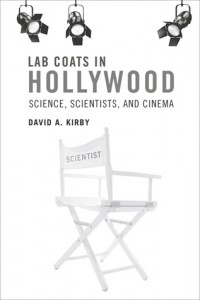 As a neuroscientist interested in science communication, I’ve been following online notice boards and forums providing a platform for those in the very diverse practice to broadcast opportunities to engage. While I have found this to be focused less on scientists taking the initiative to communicate and more on the broad stroke science events and on calls for press release writers, it has given me some unique insights and opportunities that have aided my attempts to learn about the practice. Stories about Science 2015 (#SciStories2015 on twitter) appeared on the forum as a conference held in Manchester exploring science communication and entertainment media. This notice was a wonderful opportunity for me, as much of my interest in science communication and the public sphere has been shaped by Lab Coats in Hollywood, written by Senior Lecturer David A. Kirby (also the host of this conference). In his research at the Center for the History of Science, Technology and Medicine at the University of Manchester, Kirby explores how entertainment medias serve as vehicles for science communication focuses on the academic study of how the sciences become cultural products. The range of this field can be quite broad. The papers I heard presented at the conference covered everything from an analysis of 19th century astronomy lectures to an assessment of the structure and goals of the science communication sub-Reddits and IFLS. Exploring the integration of science into these cultural products brought up questions about the nature of science itself, its definition and inclusions and its own status as a cultural product, as well as questions of story telling and audience.
As a neuroscientist interested in science communication, I’ve been following online notice boards and forums providing a platform for those in the very diverse practice to broadcast opportunities to engage. While I have found this to be focused less on scientists taking the initiative to communicate and more on the broad stroke science events and on calls for press release writers, it has given me some unique insights and opportunities that have aided my attempts to learn about the practice. Stories about Science 2015 (#SciStories2015 on twitter) appeared on the forum as a conference held in Manchester exploring science communication and entertainment media. This notice was a wonderful opportunity for me, as much of my interest in science communication and the public sphere has been shaped by Lab Coats in Hollywood, written by Senior Lecturer David A. Kirby (also the host of this conference). In his research at the Center for the History of Science, Technology and Medicine at the University of Manchester, Kirby explores how entertainment medias serve as vehicles for science communication focuses on the academic study of how the sciences become cultural products. The range of this field can be quite broad. The papers I heard presented at the conference covered everything from an analysis of 19th century astronomy lectures to an assessment of the structure and goals of the science communication sub-Reddits and IFLS. Exploring the integration of science into these cultural products brought up questions about the nature of science itself, its definition and inclusions and its own status as a cultural product, as well as questions of story telling and audience.
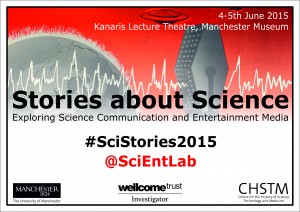 I’d like to explore some of these themes with you through a summary and elaboration of the roundtable discussion held on the second day of the conference. The discussion was centered around the following question: What can practitioners learn from academic work exploring science communication and entertainment media? As a neuroscientist interested in using story and narrative as tools to improve the integration of knowledge from my field into common understanding, attitude, and practice, I was eager to hear what themes these academics had drawn from their study of previous efforts at science communication and what advice they had to offer while also participating in the discussion and development of these ideas myself.
I’d like to explore some of these themes with you through a summary and elaboration of the roundtable discussion held on the second day of the conference. The discussion was centered around the following question: What can practitioners learn from academic work exploring science communication and entertainment media? As a neuroscientist interested in using story and narrative as tools to improve the integration of knowledge from my field into common understanding, attitude, and practice, I was eager to hear what themes these academics had drawn from their study of previous efforts at science communication and what advice they had to offer while also participating in the discussion and development of these ideas myself.
The THEMES
– What practitioners are attempting to communicate science?
– What do we mean when we say “Science Communication”?
– What audiences consume stories about science?
– The power of stories and their manual “Stories for Scientists”
What practitioners are attempting to communicate about science?
The participants in the discussion considered who they sought to advise when relating important thematic elements of science communication. Their list included journalists, novelists, museum staff, public engagement practitioners, filmmakers and TV, and university staff and researchers. While much of the discussion focused on researchers attempting to participate in science communication, it is important to acknowledge efforts to integrate scientific information into the public knowledge may come from people with many backgrounds, and that this influences the strategies they take. In some cases the incorporation of science into public awareness may be the deliberate, particular aim, in others, the science may be there primarily to augment a different story. Thus, the practitioner’s skills and the medium through which they choose to present the science will change the challenges and stories that take shape.

What do we mean when we say “Science Communication”?
One of the points brought up early on in the discussion was the vague and implicit nature of the term “science communication”. While we can use this term to communicate to others a sense of what we refer to, there are many categories with a large amount of overlap within the concept. Even the term “science” is vague. While we have formal categories, often used by universities, such as “microbiology” or “physics”, we also have data collected by amateurs in a variety of formal and informal settings, disciplines that potentially span the boundaries of the division between “humanities” and “sciences” such as archaeology (which the conference discussions concluded to be a science because of its extensive use of DNA analysis, MRI scans, and carbon dating, among other traditionally ‘scientific’ practices collecting data), popular science books, crowd-sourced galaxy categorization (see GalaxyZoo), etc. Even the potentially solid categories have been perpetually defined and redefined over the course of human history. Western medicine has incorporated wider disciplines through our advances in robotics (surgeries and bioengineering) and discarded ritualistic tools meant to exorcise the tiny devils we cannot see (bacteria). What we think is true in one era may be proven gloriously wrong in another. Part of science communication can be about pushing people to think about what we put into the word “science”.
But let’s say you have a specific, defined scope of science in mind. How do you know you have effectively “communicated” that science? This measurement is difficult, and sometimes impossible. In educational settings and events, you may be able to measure the results via test or survey, but with other forms of communication that are more influential to attitude (entertainment media) and interest (perhaps newspapers) or through which the practitioner-audience interaction is indirect (an article), measurement may be difficult. The best we can do it to have some specific goals in mind for the product, whether it be an article, event, or film, and to know our audience and how they consume science.
What audiences consume stories about science?

The context any particular audience brings to the conversation about science is crucial information for those attempting effective communication. Knowing the audience’s interest informs the details you choose to focus on to draw sustained attention. Knowing the context with which they view the science tells you what information and assumptions they are already working with- what they will expect, what their current paradigm is, and what other ideas they might bind to the new ones you introduce. New knowledge must be built upon a baseline that already exists and must be incorporated into a new worldview slowly and complementarily by small changes, rather than as a confrontation of a network of assumptions and knowledge the audience has previously constructed. This is why the Pluto announcement drew so much attention in the public sphere. Rather a reclassification than new information about Pluto, its demotion at first drew outrage and rejection because it conflicted with the world order they imagined immutable.
Audience context during the delivery of the communication medium also matters. These stories about science are consumed. An audience has a more complicated interaction with the communication medium than a passive receiver of information. To be effective, a communicator must get at what the audience is thinking about when they take in the story you deliver. If an audience is receptive to a formal educational presentation, you don’t want to construct a story about the science that leaves them feeling it was ‘magic’, unexplained or poorly explained. This inconsistency can eject them from acceptance of the rest of the evidence presented. On the other hand, if the audience is looking for entertainment and enchantment, over-explanations can interrupt the flow of enthusiasm. Very often pubic engagement is not about setting out to teach the masses, but is instead a quest to generate wider passion for what you do. Passion-based learning is a common principle of education and communication that the story format neatly employs. It creates a relationship between the audience and the concept that captures their attention. In the best cases, it also creates or strengthens a relationship between the audience and the scientist or communication practitioner. As a scientist practicing science communication, it is important to remember the story you tell about science is not just about the facts, however fascinating you find them. The story also includes you. People want to see you as a human, to connect with you as a person whose passion about science they can sympathize with and reflect. Science itself is not an isolated body separate from society. It is to a large degree a societal construct; it necessarily includes stories about people. Society participates in scientific research to explore questions of humanity and its place in the universe. It defines what constitutes science, how we interpret the data we collect, what we pursue, how we employ what we discover, and how we value what we discover. Scientific exploration is carried out by people, and is therefore also subject to the biases, priorities, and human experiences of those people. The process of generating reliable knowledge is shaped by social forces like politics, popular conception, and funding based on current concerns. Attempting to deliver stories about science from a perspective that cuts out the crucial role of society in science and people in science, thereby attempting to deliver the facts a la mode, dilutes the value and relevance of those facts and the story you try to tell.
It is therefore not enough to wait for journalists and audiences to “understand science more”. Scientists must participate in the interaction between science and society because they generate the information and innovation society will consume an integrate into its collective understanding of the universe. Scientists necessarily mediate some aspects of this process, and have a responsibility to put conscious attention into how they do so.
We must therefore understand to some degree the medium through which we try to relay information and stories about science. If we speak about it through journalism, we must understand what journalists need from us to make the story worthwhile. If we want to communicate through entertainment, we need to understand the nature, priorities, and limitations of entertainment. We must choose the right tool for the right information and the right audience with specific goals in mind about the effect we wish to achieve.

The power of stories and their manual “Stories for Scientists”
The enormous amount of data we are currently able to generate in the Digital Age has progressed many scientific fields quite rapidly and has made it more difficult for even the experts to grasp the extent and complexities of their field (forcing more sub-specializaiton), let alone non-specialists. This challenges scientists to acquire new skills in communication to avoid the prospect of exclusionary bubbles of scientific research separating from each other and the main body of society in a process that would sever the science from that which feeds and nurtures it and society from those functions that give it life, energy, and direction.
But how to de-mystify or reintegrate science into the cultural outlook? As the name of the conference which discussed this suggests, perhaps we should tell stories. Many scientists may worry that they are selling the audience something they don’t want when they reach out to relay the knowledge of their field. After all, if the audience was interested, would they not have pursued the same field themselves? But everyone tells stories. Everyone wants stories. Their values lies in their ability to help us make sense of the world around us, predicting what will happen next, understanding the motive behind the actions of others, and illustrating the possibilities that could exist in the future. The art lies in using the story to illustrate why the science it features is personally relevant to the audience’s lives, their experience or understanding of the world, and their identities.
Everyone tells stories in different ways. A journal article will tell a very different story than will a demonstration table, and a documentary featuring science may tell a very different story than a blockbuster film using science for dramatic effect and catalysis. Even scientific articles tell stories. However, in these, the convention encourages scientists to write in the passive voice, avoiding agency. They restrict discussion of mistakes, failures, missteps, trial and error, and unguided exploration. While to some degree this is an effort to condense months or years worth of work into a concise and reproducible format for others in the field, it also couches the important concepts presented in a language that makes them difficult to access for those from without.
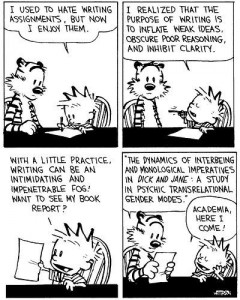 [One might argue that instant accessibility to every paper published might only further encourage the over interpretation and overextension of findings that one sees all to often in media (the fallacy that X correlated with Y under conditions C, D, and F means that X always causes Y). I counter this by arguing that this overlooks the responsibility science communication practitioners have of telling the story of messy science, the scientific method, the influence of social forces, and of the variety of different or even conflicting conclusions different experts might draw from the same data set. Part of the task of science communication is integrating an appreciation of science as a process, which generates a stable but still imperfect model of the world over a long period of time and through many challenges, perhaps being proven wrong and wrong again until something more lasting and reliable emerges.]
[One might argue that instant accessibility to every paper published might only further encourage the over interpretation and overextension of findings that one sees all to often in media (the fallacy that X correlated with Y under conditions C, D, and F means that X always causes Y). I counter this by arguing that this overlooks the responsibility science communication practitioners have of telling the story of messy science, the scientific method, the influence of social forces, and of the variety of different or even conflicting conclusions different experts might draw from the same data set. Part of the task of science communication is integrating an appreciation of science as a process, which generates a stable but still imperfect model of the world over a long period of time and through many challenges, perhaps being proven wrong and wrong again until something more lasting and reliable emerges.]
These scholars of science communication stressed that they were not suggesting scientists shift to storytelling instead of their current practices (giving lectures, doing demos, etc), but rather that they encouraged embedding storytelling in these activities. A strategy to do so includes switching to the active voice, thereby involving new actors and describing a personal process a relatable character, the scientist, went on to discover this exciting information. As described above, the science storyteller should also give thought to the audience’s context and interests and the type of story they are trying to tell.
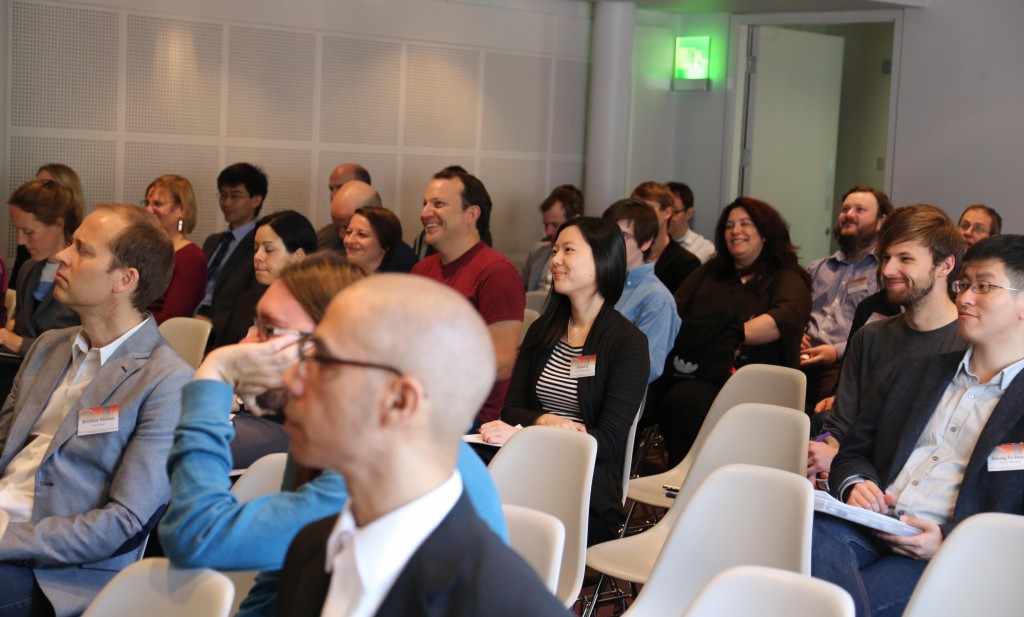
Narrative is a powerful tool for communication. Some of its power is implicit and latent: it projects a whole world view that concretizes certain assumptions about parts of that world, encouraging the audience to make those assumptions too; to feel they are part of reality. Narrative also grants agency, which may be dangerous when the structural forces at play are difficult to convey in the narrative format (ex. “evolutionary design”).
It is also a tool that requires practice and training. Not everyone may be immediately skillful in it its use. The conference attendees also stressed that this should not be taken as a prescription that scientists need go out and communicate. Anyone seeking to tell stories about science must be reflective and wise, as it is a political act to tell a story. Such a statement, necessarily framed in a particular world view, will imply particular political agenda, and the discussion advised consideration of the nature of this political agenda.
The discussion wrapped up on a note of optimism, as one woman pointed out that while science communication should seek to de-mystify science and foster its integral role in our society, we should also remember to value enchantment, as we seem to need it in the world in which we live. As Terry Pratchett wrote, “It doesn’t stop being magic just because you know how it works.” So tell stories. Craft them to use science to shape our worldview. Generate passion and enchantment and excitement (and funding). Recall that science is a social process, driven and shaped by humanity, and that as a critical part of humanity’s quest to understand itself and the universe, it must maintain the democratic agency and relevance bestowed by being used and valued.
Kira Rienecker is a Wellcome-trust funded PhD student in the Integrative Neuroscience Program at Cardiff University. Take a look at Kira’s website for more information: I Have A Gene: Shaping Neurology With Epigenetics
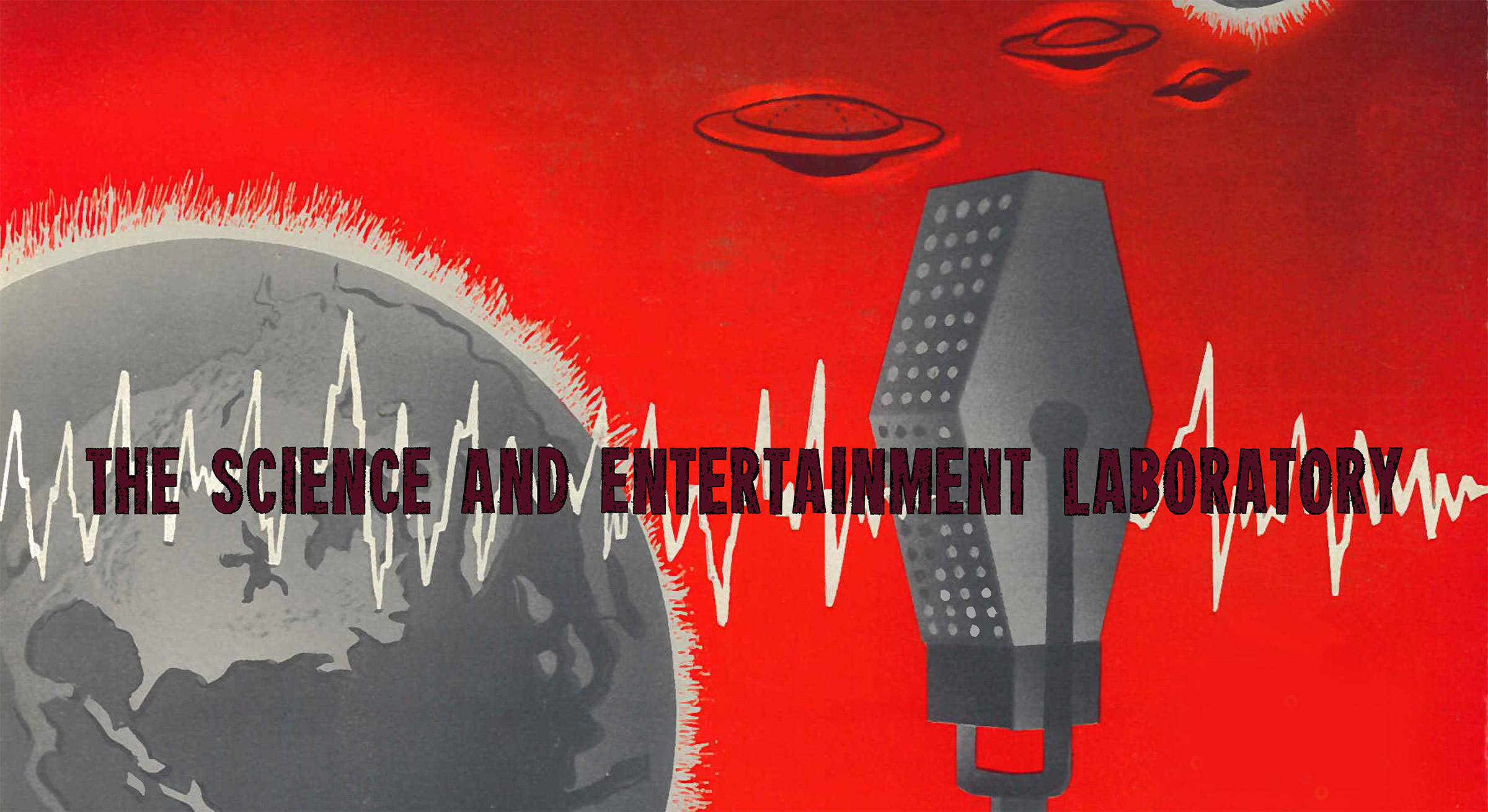
 Follow
Follow